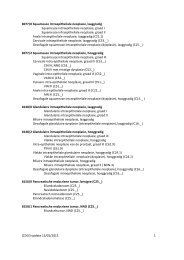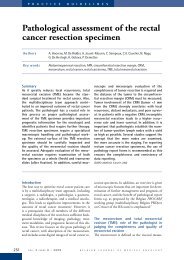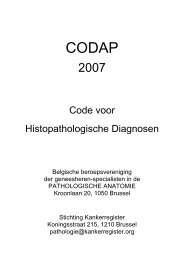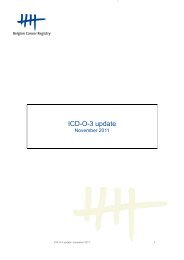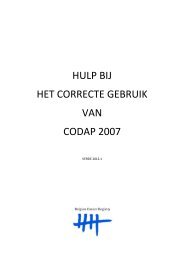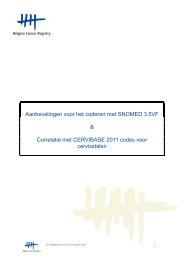Assurance de qualité pour le cancer rectal – phase 2 ...
Assurance de qualité pour le cancer rectal – phase 2 ...
Assurance de qualité pour le cancer rectal – phase 2 ...
Create successful ePaper yourself
Turn your PDF publications into a flip-book with our unique Google optimized e-Paper software.
KCE Reports 81 PROCARE <strong>–</strong> <strong>phase</strong> 2 193.2 RESULTS3.2.1 Description of study cohorts3.2.1.1 Prospective PROCARE cohortFor the present study, patient inclusion was stopped on December 4 th 2007. At thattime, 1071 patients with <strong>rectal</strong> <strong>cancer</strong> were inclu<strong>de</strong>d, involving 56 centres and 98surgeons. More then 60% of these patients are ma<strong>le</strong>s, and about 75% is 60 years orol<strong>de</strong>r (Tab<strong>le</strong> 1). Mean age is 67 years (SD 12).The number of inclu<strong>de</strong>d patients per hospital ranges from 1 to 87, with a mean of 19patients per hospital (SD 16). Twenty-one centres inclu<strong>de</strong>d 20 patients or more.For about one third of patients the clinical stage is unknown (Tab<strong>le</strong> 2). The main reasonis insufficient information on the cT and/or cN to calculate the clinical stage. Of thepatients with a known clinical stage, 49% has cStage III.About 64% of all patients received neoadjuvant treatment (Tab<strong>le</strong> 3). More specifically,66% of the cStage II patients and 85% of the cStage III patients received neoadjuvanttreatment. Only 1% of the patients was not treated with surgery, whi<strong>le</strong> 28% wasexclusively treated with surgery (Tab<strong>le</strong> 4). Tab<strong>le</strong> 5 c<strong>le</strong>arly shows a shift towards lowerstages from cStage to (y)pStage. Importantly, two different e<strong>le</strong>ments are covered by the(y)pStage. First, in patients not treated with neoadjuvant treatment (and morespecifically those patients not treated with a long course of neoadjuvant radiotherapy),the shift from cStage to pStage could represent a wrong clinical staging. On the otherhand, in patients treated with neoadjuvant treatment (mainly those patients treated witha long course of neoadjuvant radiotherapy), a shift from a given cStage to a lowerypStage also represents a downstaging.Tab<strong>le</strong> 1. Age and gen<strong>de</strong>r distribution according to used databases*.PROCARE databaseAdministrative databaseAge Ma<strong>le</strong>s Fema<strong>le</strong>s Total (%) Ma<strong>le</strong>s Fema<strong>le</strong>s Total (%)? 1 1 2 (0.2%) 0 0 0 (0.0%)20-24 0 0 0 (0.0%) 2 3 5 (0.1%)25-29 1 1 2 (0.2%) 2 2 4 (0.1%)30-34 1 2 3 (0.3%) 15 14 29 (0.4%)35-39 5 6 11 (1.0%) 29 26 55 (0.8%)40-44 16 11 27 (2.5%) 70 52 122 (1.7%)45-49 26 16 42 (3.9%) 124 105 229 (3.2%)50-54 39 24 63 (5.9%) 279 176 455 (6.4%)55-59 82 46 128 (12.0%) 402 237 639 (9.0%)60-64 99 54 153 (14.3%) 512 297 809 (11.4%)65-69 109 66 175 (16.3%) 711 383 1094 (15.5%)70-74 113 55 168 (15.7%) 765 439 1204 (17.0%)75-79 76 52 128 (12.0%) 643 485 1128 (15.9%)80-84 66 55 121 (11.3%) 363 373 736 (10.4%)85+ 22 26 48 (4.5%) 215 350 565 (8.0%)Total 656 (61.3%) 415 (38.7%) 1071 (100%) 4132 (58.4%) 2942 (41.6%) 7074 (100%)* Chi-Square (for age distribution) 53.3208, p < 0.0001Tab<strong>le</strong> 2. Distribution of cStage according to used databases*.PROCARE database Administrative database0 1 (0.1%) 10 (0.4%)I 107 (14.5%) 446 (16.9%)II 160 (21.7%) 801 (30.4%)III 357 (48.5%) 813 (30.8%)IV 111 (15.1%) 567 (21.5%)0-IV 736 (100%) 2637 (100%)X 335 4437Total 1071 7074* Chi-Square 75.9994, p < 0.0001



